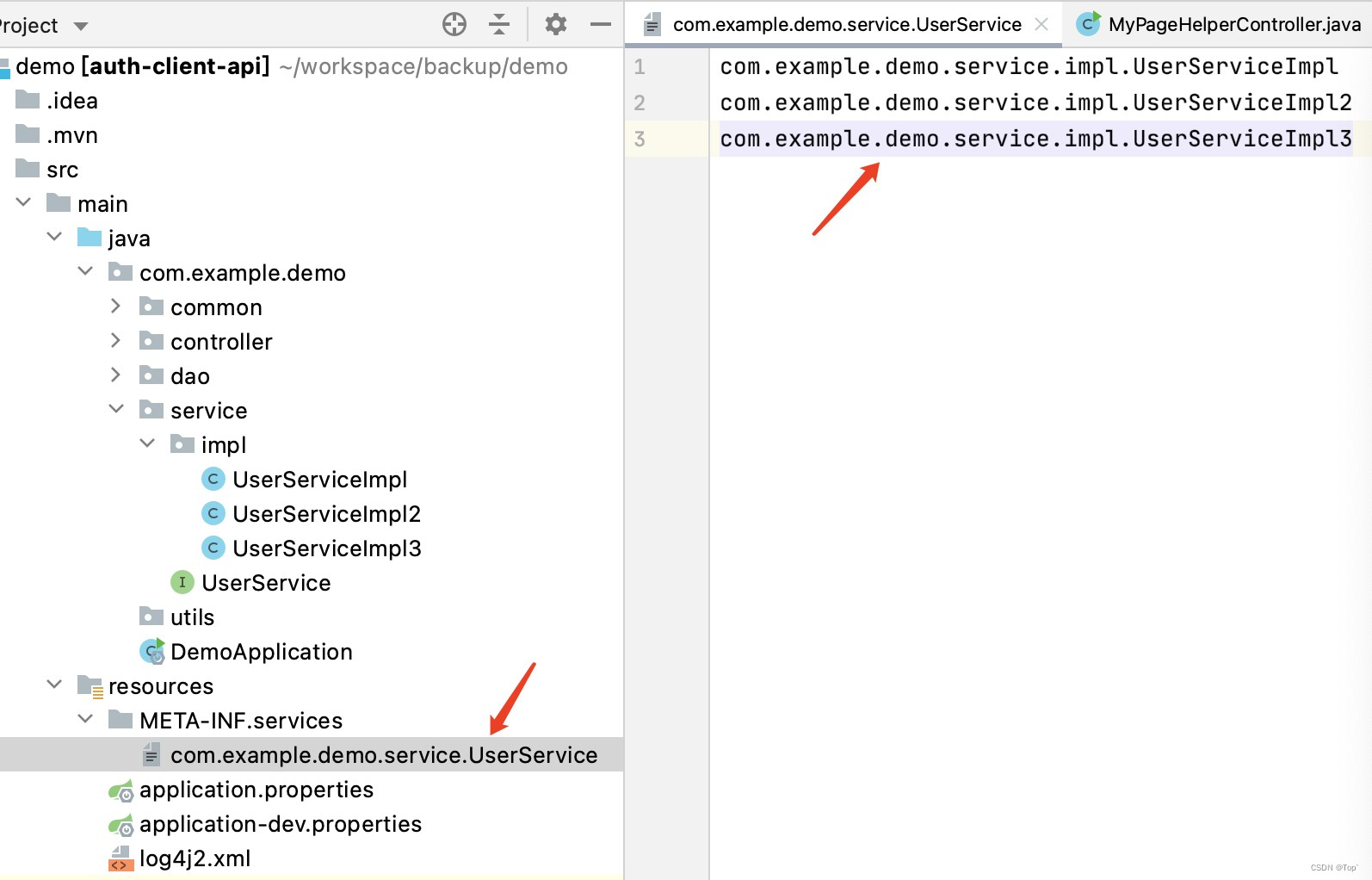一、获取接口所有实现类
方法1:JDK自带的ServiceLoader实现
ServiceLoader是JDK自带的一个类加载器,位于java.util包当中,作为 A simple service-provider loading facility。
(1)创建接口
package com.example.demo.service;
import java.text.ParseException;
public interface UserService{
void register() throws ParseException;
}
(2)创建实现类
第一个实现类UserServiceImpl
package com.example.demo.service.impl;
import com.example.demo.common.HfiTrace;
import com.example.demo.service.UserService;
import org.springframework.stereotype.Service;
@Service
public class UserServiceImpl implements UserService {
public UserServiceImpl(UserServiceImpl2 userServiceImpl2) {
//由于构造函数先于依赖注入执行,所以这里执行的时候postConstructTest2还没有注入,所以报错
userServiceImpl2.register();
}
@Override
@HfiTrace
public void register(){
System.out.println("register user");
}
}
第二个实现类 UserServiceImpl2
package com.example.demo.service.impl;
import com.example.demo.service.UserService;
import org.springframework.stereotype.Service;
@Service
public class UserServiceImpl2 implements UserService {
@Override
public void register(){
System.out.println("register user");
}
}
第三个实现类 UserServiceImpl3
package com.example.demo.service.impl;
import com.example.demo.service.UserService;
import org.springframework.stereotype.Service;
@Service
public class UserServiceImpl3 implements UserService {
@Override
public void register(){
System.out.println("register user 3");
}
}
(3)在resources目录下添加:META-INF/services/目录,新增一个文件:用你的接口全路径名称命名一个文件(不加后缀),然后在该文件中一行一个添加你的接口实现类的全路径名。

(4)在第三步新增的文件中,添加接口所有实现类的全路径名,如:

(5)测试
ServiceLoader<UserService> load = ServiceLoader.load(UserService.class);
Iterator<UserService> it = load.iterator();
while (it.hasNext()) {
UserService service = it.next();
service.register();
}
//for(UserService userService : load){
// userService.register();
//}
方法2:使用Spring自带的方法
Application.getBeansOfType();
Spring作为一个容器,管理着一个项目中所有经过配置的Java类(xml配置文件或Annotation方式)。如果某个接口的所有实现类均被Spring托管了,那么通过Spring就可以很简单的返回这些实现类。
@Component
public class userServiceLocator implements ApplicationContextAware {
/**
* 存储 UserService接口的所有实现类
*/
private Map<String, UserService> userServiceMap;
private List<UserService> userServiceList;
@Override
public void setApplicationContext(ApplicationContext applicationContext) throws BeansException {
// 通过上下文,根据接口类型返回相应的所有实现类bean
userServiceMap = applicationContext.getBeansOfType(UserService.class);
userServiceList = new ArrayList<>(userServiceMap.values());
}
/**
* 获取所有实现类
*
* @return
*/
public Map<String, UserService> getAllMap() {
return userServiceMap;
}
/**
* 通过名称获取某个实现类
*
* @param beanName
* bean名字
* @return
*/
private UserService getByName(String beanName) {
return userServiceMap.get(beanName);
}
/**
* 获取所有实现类
*
* @return
*/
public List<UserService> getAllList() {
return userServiceList;
}
/**
* 根据枚举获取某个实现类
*
* @param xxxTypeEnum
* @return
*/
public UserService get(XxxTypeEnum xxxTypeEnum) {
UserService xxxService = userServiceList.stream().filter(s -> s.isSupport(xxxTypeEnum))
.collect(Collectors.toList()).get(0);
return xxxService;
}
}
二、策略模式典型应用
spring自动注入接口的多个实现类(结合策略设计模式)
在使用spring开发的时候,有时候会出现一个接口多个实现类的情况,但是有没有有时候有这样一种情况,就是你的逻辑代码里面还不知道你需要使用哪个实现类,就是比如说:你去按摩,按摩店里面有几种会员打折,比如有,vip、svip和普通用户,那按摩店里面是不是需要对这些会员定义好不同的折扣,然后根据每个用户不同的会员计算出不同的消费情况
虽然这样的情况,对于一般人来说,第一眼肯定就是说,直接加 if else 去判断就可以了
这样做,对于实现功能而言,肯定是没问题,如果以后这个按摩店又增加一种会员,那你是不是又要去修改你的逻辑代码去在加一个 if else ,这样就违反了系统架构设计的开闭原则,这样写if else 也使你的代码看起来不优雅。
在代码里面,我们可以先定义一个DiscountStrategy接口类
//顶层会员接口,这个接口的实现类有多个
public interface DiscountStrategy {
public String getType();
public double disCount(double fee);
}
然后在写他的几个实现类
/**
普通用户实现类
*/
@Service
public class NormalDisCountService implements DiscountStrategy {
public String getType(){
return "normal";
}
public double disCount(double fee){
return fee * 1;
}
}
/**
会员实现类
*/
@service
public class VipDisCountService implements DiscountStrategy{
public String getType(){
return "vip";
}
public double disCount(double fee){
return fee * 0.8;
}
}
/**
svip超级会员实现类
*/
@Service
public class SVipDisCountService implements DiscountStrategy {
public String getType(){
return "svip";
}
public double disCount(double fee){
return fee * 0.5;
}
}
解决方案
然后当一个用户进来消费的时候,根据你当前的身份去打折扣
定义一个map集合,然后把所有的实现类都放入到这个集合中,然后根据当前的会员类型去进行不同的操作
@Service
public class DisCountStrageService {
Map<String,DiscountStrategy> discountStrategyMap = new HashMap<>();
// 构造函数,如果你是集合接口对象,那么久会把spring容器中所有关于该接口的子类,全部抓出来放入到集合中
@Authwired
public DisCountStrageService(List<DiscountStrategy> discountStrategys){
for (DiscountStrategy discountStrategy: discountStrategys) {
discountStrategyMap.put(discountStrategy.getType(),discountStrategy);
}
}
public double disCount(String type,Double fee){
DiscountStrategy discountStrategy =discountStrategyMap.get(type);
return discountStrategy.disCount(fee);
}
}
测试类
@RunWith(SpringRunner.class)
@SpringBootTest
public class MzySpringModeApplicationTests {
@Autowired
OrderService orderService;
@Autowired
DisCountStrageService disCountStrageService;
@Test
public void contextLoads() {
//orderService.saveOrder();
double vipresult = disCountStrageService.disCount("vip",100d);
double svipresult = disCountStrageService.disCount("svip",100d);
double normalresult = disCountStrageService.disCount("normal",100d);
System.out.println(vipresult);
System.out.println(svipresult);
System.out.println(normalresult);
}
}
其实这就是java设计模式的策略模式,只不过就是用构造函数注入到list集合中